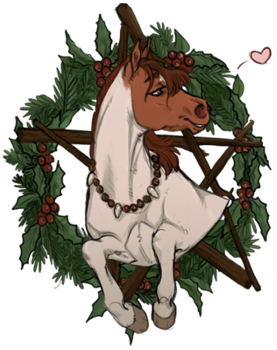There is a lot more than just scratches or shiny marks that horses can be docked points for. I might be able to help out, although it's harder to tell from pictures. Some general guidelines for deciding if a horse is Live Show Quality, or LSQ, or not that I follow are-
-No wear and tear, meaning no scratches, rubs, breaks, etc. Some things you can fix up a little bit before a show. For example with a model like Stud Spider, who is mostly black, if he has a
very small ear tip rub, you can probably use a black marker to cover that spot. This can't be obvious, but is allowed at most shows if unnoticeable. Another way to fix up models is if they have black or other colored scuff marks on their white markings, ONLY IF THE MARKINGS HAVE BEEN MASKED, NOT PAINTED ON, you can use a very small amount of acetone (nail polish remover, acetone-free nail polish remover works as well) on a cotton swab and it normally clears those right up. Remember, it'll also take off the actual paint very easily, so you have to be very careful with it and use as little as possible so it doesn't run or drip
-No obvious seam lines. Some models have pretty obvious seam lines- where the two halves of the model were connected during production, as well as extra pieces of plastic as a result of parts of production that are supposed to be removed by sanding. These will not do very well in show. You want a model that is as smooth as possible. Most seam lines can be visible on the back, belly, hooves/legs, and mane, tail, etc.. Earlier models are actually pretty good about seam lines because they did not have as many details that production workers have to be careful of sanding down. This is one that is very hit-and-miss in models, but definitely a contributing factor
-Clean masking. If the horse has white markings, like Stud Spider's appaloosa blanket, it is very likely the markings were made by a mask. That is, when the model was being painted/airbrushed, parts of the model were covered beforehand and the rest painted. Once it was finished being painted, they'd take the masking off and reveal where the model was still white. Not all masking is put on perfectly, and there may be small gaps where overspray occurs. Overspray happens when a bit of the airbrushed paint gets underneath the mask, so the lines of the markings are not "clean"- they are faded and not as sharp. Older models are very prone to this, but models nowadays also get some spots with a bit of overspray. Crisp markings are your friend. This also definitely includes horses with lighter colored manes and tails- the best show models don't have any of the mane and tail color overlapping onto the neck/back/legs.
-Good coloring/shading. Some models have pretty bland shading. That is, there is not much of a difference in all their coloring- they look flat in color. Horses with shading airbrushed in all the right places are more appealing in the show ring. This is harder for more darker colored horses, but for horses that aren't, you want a realistic looking horse, including in the shading. If it looks all to be mostly one color it's not as appealing as a horse that varies in shade like a real horse would. This can be very hit and miss since all Breyers are hand painted. Dappling is another good example. Some dappled horses have barely any dappling at all, or really ugly dappling- such as "fish scales" that look like fish scales due to the way they were airbrushed on.
Here is an example of a horse without much dappling, and
one with a lot, and
one with what I'd personally consider fish scales. All of them are the same type of model, Argyle. As far as I've seen, judges seem to like more extensive dappling.
-No warping/bent legs/etc.. I had a difficult time this year getting my Silver molds ready for show because they are very prone to having bent tails, so that when standing, the tail wont sit flat on the table. I had to scratch one from my roster because of this. Legs are the same- sometimes they are bent out at a weird angle so that all hooves that should be on the table aren't flat on the table- one might be tilted a little. This can be fixed to some extent, using either hot water or a hair dryer, to heat up the plastic of the leg/tail so that it softens enough to be bent into place. However, thicker pieces, such as a Silver mold's tail, are harder to bend without the risk of breaking. This is important in shows. Judges are looking at them as if they are real horses, and if a real horse had a bent leg, you'd be pretty concerned about it and dock points for bad conformation!
There's a lot of factors that contribute to an LSQ horse, but those are just some that I've found to be the most important. It's also a judge's preference. Just remember that, depending on what class your horse is going in, they might be going up against horses of the exact same model, so the one that looks the most realistic or clean and well made is probably the one that is going to win.





































